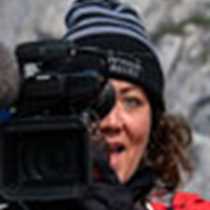After having spent the night anchored near the White Cliffs of northern West Island, we set sail in the early morning and headed around to Port William on the eastern side of East Falkland Island. From here, National Geographic Orion slowly made her way to the inner harbor of Port Stanley, where she anchored just off the center of Stanley. Stanley has been the capital of the British dependency of the Falkland Islands since 1842. A Zodiac shuttle service was maintained for the rest of the afternoon to allow everyone to come and go as they wished. About 3,000 people, out of a total
There has long been contention over these islands between Argentina and Britain, and the two countries actually came to blows in 1982. This conflict is still prevalent in the minds of many locals and we saw numerous reminders as we travelled around the region. Stanley was held by Argentine troops for ten weeks in 1982 before being retaken by a British task force during the Battle of the Falkland Islands (or The Conflict, as the locals refer to it). Many changes have come about since then, most notably the expansion of the suburbs in both directions along the waterfront. Stanley is great fun to explore on foot, because there are good shopping and pub crawling opportunities. The colorful houses, with their front porch greenhouses and peat smoke (and the accompanying burning peat smell) are very picturesque, as is the Christ Church Cathedral, with its famous whale jaw bone arch.
Most guests enjoyed an afternoon tour of Stanley and its environs, including a view of Government House, the two main war memorials (one for the Battle of the Falklands during World War I and another for the Falklands Conflict of 1982), and a drive around the eastern end of the harbor to view the wreckage of the LADY ELIZABETH (a 19th century iron barque which limped into Stanley Harbor in 1912 after sustaining damage in a storm coming around Cape Horn). Nearby, closer to shore, is a veritable boat graveyard, where we saw the remains of numerous smaller wooden vessels slowly disintegrating in the shallows. We also marvelled at the Totem Pole, a sign post erected by the military which indicates the mileage to their home towns in Britain, and stopped at the town peat bog, which used to be the main source of fuel for the town. In my mind, however, the highlight of this tour was the Falkland Islands Museum, which houses an amazing eclectic collection of anything having to do with the human or natural history of the Falklands. There was still enough time after the tour to explore the town on our own and many of us ended up in The Globe pub for a pint or two.
We had planned to take on some provisions here in Stanley, but since we did not use the big wharf far outside of town, the provisions were brought out to us by local boat and loaded aboard by hand on the Marina Deck. Fortunately, nothing was dropped into the sea and no eggs were broken! In the early evening, we retraced our route back out of Stanley Harbour and through Port William into a rather lumpy open sea, and were excited to set our course towards South Georgia.
After dinner, we were enthralled to see a Super Moon, which coincidentally was also a Blue Moon this month, lighting up the wave crests and producing amazing reflections. After a while, thick clouds covered her in the eastern section of the sky and we were also treated to some impressive stars, including the Southern Cross.









